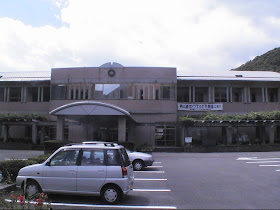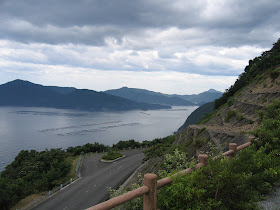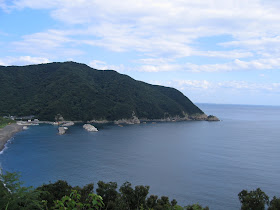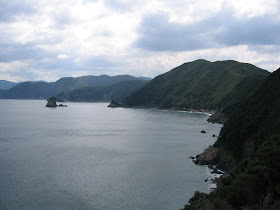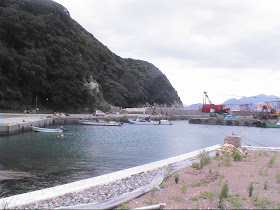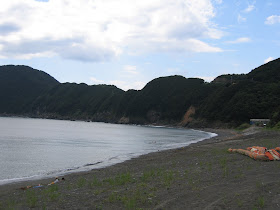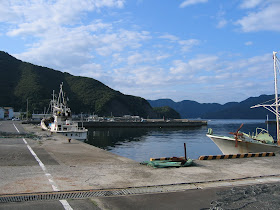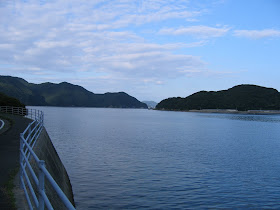Monday, August 17, 2009
Shortly after I first arrived in Japan, there was a welcome party for the new JETs in Kamae town, at the Kamae Marine Cultural Center.
I had been in Japan for less than 2 months at that point. Because I tend to make friends slowly, I was still uncomfortable around everyone.
Also I wasn't drinking that night, but it was a wild night of binge drinking for just about everyone else.
So I remember it as an awkward night of being dead sober around a bunch of drunken people I wasn't comfortable with.
(I also remember one of the Canadian JETs got drunk and threw up on himself, and then as me and another fellow tried to help him, he was so far gone he spoke to us only in Japanese, despite us repeatedly telling him there were no Japanese people around.)
After that night the JET community was, as a group, henceforth banned from the Kamae Marine Cultural Center. Apparently the skinny dipping in the middle of the night was the straw that had broken the camels back. It was the first of many places we ended up getting banned from that year.
Despite all this, I had great memories of that weekend. The drive down there through places like Saiki and Yonozu (see previous post) had been absolutely beautiful. And Kamae town itself was breathtakingly gorgeous.
The next day we went swimming at one of the beaches in Kamae, and my mind could barely take in all the scenery. The green mountains that went right up to the coast line against the blue ocean, the black dirt on the beach, the palm trees, the waves, the Japanese houses built onto the hillside next to the beach...my words aren't doing it justice, but I thought it was the most beautiful place I had ever been to.
Because of this, I've always been wanting to get back down to Southern Oita and re-visit places like Kamae, but never really found an excuse to do so. One of the big reasons I started this whole project is so that I would have an excuse to thoroughly explore Southern Oita. It's taken me a while, but now I'm back in Kamae town, the southernmost coastal town in Oita prefecture.
From Saiki city I was able to take a tunnel up near the top of the mountain that led me across the boarder into Kamae town.
Almost immediately after the tunnel was a small road side shrine with a great view of the town below.
Because this was so soon after exiting the tunnel, the first time I accidentally drove past it, and went through all the trouble of turning the car around and coming back.
Funny enough, from the actual shrine you don't get a view at all because the plants are in the way. But if you want to risk your life standing on a mountain road with no shoulder as big trucks go by, you can get a great view from the roadside.
I decided to risk it and took a couple pictures.


Next stop was the local road stop (michi no eki) for Kamae, where I picked up some information and tourist brochures.
Kamae itself is a small town, but the michi no eki was very busy that day. Perhaps because it was still Obon holidays.

Looking at the map, I could see that Kamae was like most of the coastal towns in southern Oita. The coast line was anything but a straight line or a smooth curve, but instead a mess of jutting peninsulas, bays and coves. It looked like there were plenty of beautiful beaches to be seen, but I would once again have to put up with a long and winding coastal road.
There was also a waterfall indicated on the map: takeiuchi keikoku. It looked like it was slightly up in the mountains, but since I love waterfalls, I decided I should see it. And I decided I might as well get it out of the way first thing so I could spend the rest of the day along the coast.
Because roads usually aren't named in Japan, it was difficult figuring out where exactly this waterfall was. According to the map I was to follow the coast road for a while, then go through a tunnel, and then shortly afterwards a small side road on the left would branch out, and I would follow this to the waterfall.
I was hoping the roadsigns would help me find the waterfall where the map was less than specific, but there was nothing.
This was the first indication that the waterfall might not be worth seeing.
So, after driving back and forth along the coast for a while, I decided to just try and find it on my own. I turned off one of the first roads after the tunnel, and wandered around that neighborhood.
Almost everything was under construction that day. I drove around several construction sites before the road was flat out blocked, and I could get no further.
At this point I almost gave up, but the picture of the waterfall on the map looked so inviting I really wanted to see it in person. (The picture, by the way, was drawn on. The waterfall was one of the few things in the tourist map in which an actual photo was not included, and instead just a painted picture of the waterfall was on the map. But the picture still looked pretty cool: water cascading down two different ledges to collect in a pool at the bottom).
I back tracked, and decided to see if there was another way through.
After some more wandering, I stopped at the local police branch to ask for directions.
There were two people standing outside talking. They seemed slightly annoyed when I approached them for directions, but they obliged me.
One of them didn't even know where it was, and had never heard of it before. (Yet another sign this waterfall wouldn't be worth seeing.)
The other one was a bit more help. "Yeah, it's just right down there. Just follow this road. Or take that one," he said, pointing to the other road I had just been down. "Actually that one might be better."
"I just came from that way and there was construction, so I couldn't get through."
"No, you can still get through," he said decisively.
You couldn't, but I didn't feel like arguing, so I just thanked them, and drove on.
I drove around more construction sites, and eventually the road turned into a gravel and dirt trail. I stopped the car and started walking for a bit at this point, but I soon gave up. At this point, I really was done.
In the distance, I saw a river flowing down the mountain, and wondered if this might be the waterfall. It's possible that a trail didn't even lead up to it, and you were just supposed to admire it from a distance. That would explain why there were no signs anywhere.
I drove back and got back on the coastal road.
Then I returned to a long drive following the winding coast.
At different points I would stop the car to get out and take pictures of various things, but for the most part I didn't capture the drive on film very well, and you'll just have to take my word for the fact that it was incredibly scenic.
I stopped at a small park by the seaside called Maruitibi for a couple pictures.

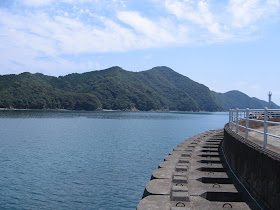
And I stopped by Kazurahara beach. There was almost no one at this beach, but it looked beautiful so I took some pictures.




Shortly after this, the coast line became entirely mountainous, and the road had to go up into the mountains for a while.
There was a look out point. The sign identified the place as "Yasuragi no michi"--or Yasuragi road. (I'm not quite sure what Yasuragi road is. There was a place called Yasuragi no michi in Tsurumi town as well. At the time I thought it was a scenic point, but after seeing two of these road signs I'm starting to believe it's some sort of path).



From here the road lead down to Hatozu beach, and it was an absolutely beautiful drive.
Although the road didn't have any shoulder for pedestrians, I couldn't resist getting some photos, so I left the car parked and walked down for a ways.
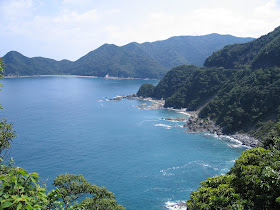




The signs along the road warned me that this was the path that the trucks took to the dump. And indeed there were several dump trucks going back and forth. It was a bit tricky driving down this road because often it was only wide enough for one car, and when I met a dump truck coming the other way I had to put the car in reverse for a while until I found a spot where they could pass me.
On foot, you were also constantly on the lookout for dump trucks driving past.
The knowledge that there was a garbage dump nearby somewhat took the shine off the romance of this area, although to be fair I never actually did see the dump. It must have been hidden out of view behind the mountains.
Once I had my pictures, I got back in the car and drove down to the Hatozu Beach park.
It was an absolutely beautiful beach, with crystal clear water.
After wandering around the beach and getting some photos, I changed into my swimsuit and went for a swim.
Unlike my swim in Yonozu (see previous post) the ocean water here was really warm. I felt like I was entering a heated pool.




The scenery was so beautiful, and the water was so clean that I didn't want to leave. But eventually I got bored just swimming back and forth, and got back in my car in search of more things to see.
I retraced my steps and drove back to the road rest station where I had started my touring.
I followed signs to the "center of Kamae town." There didn't appear to be much there. I had already picked up my maps, so I didn't bother to stop in the town hall. There were a couple banks and supermarkets, but I didn't see any coffee houses to hang out in.
Nevertheless, the whole town center appeared to be located on a small peninsula jutting out into the ocean, which gave it a bit of atmosphere. I parked my car on the side of the road, and wandered around a little bit.


I didn't stay long, largely because I realized what a terrible job I had done of parking my car. When I observed how much trouble everyone else had getting by me, I decided it was time to move my car, and go on to the next place.
I proceeded on to the Marine Culture Center.
The memory does get slightly blurry after 8 years, but I am 95% sure this is the same place we stayed at the 2001 JET welcome party.
I only vagually remembered it now, and went through the lobby not sure what to expect.
There were a couple restaurants, a souvenir shot, and an exhibit about the sea (which I didn't go into because it was paid admission).
Other than that there didn't seem to be much to the place, but I guess all the upper floors were rooms people could rent out. Perhaps this place acted like a municipally subsidized hotel for people who wanted to enjoy the ocean.
I don't remember other guests being there the night we stayed. But if there had been, I'm sure they must have been disturbed by all the commotion we caused. No wonder we were banned.
There was an outdoor swimming pool next to the Marine Culture Center. And it looked like they were charging admission to it. And it was completely full with kids, which was strange because it was right next to the ocean. I mean it looked like a nice pool and everything, but with beaches this nice right next to you, who would want to jump in the pool?



Next to the Marine Culture Center was the Motozaru Takayama beach, and it also looked beautiful. I had already been swimming once today, but I figure in this heat you can't do too much swimming.
But I decided to make a deal with myself. I wanted to see a couple more scenic points before it started getting dark, and then I would come back for a swim.
First off I went west to Seibira Mountain look out point.
This was a long drive up the mountain, but when I finally got to the top, it offered a very nice scenic view.



Next I went down this mountain, drove east, and went up another mountain to Takahira park look out point.
This was also a campground at the top of the mountain, and there were a lot of families out barbecuing.
If you hiked up the hill, there was a look out looking down at the Marine Culture Center, where I had just come from.



There was also a trail leading through the woods, which I followed for a while, but it didn't seem to be going anywhere, so I came back.

Having thus gotten in a couple more sights, I decided to reward myself by returning to Motozaru Takayama beach and going for my second swim of the day.
After getting a few photos of the beach, I changed back into my swimsuit and jumped in.


I had a good swim, although I ended up getting stung by jellyfish twice.
The first time it was just a prick on my finger. I wasn't even sure what it was until I saw a small jellyfish swimming nearby.
The second time it was a sharp stinging feeling on my arm. Like a bee sting, it felt like a small needle had jabed me. The surprise was what really made it feel painful, but the pain almost immediately faded away. (I'm from the Midwest, and don't often go swimming in the ocean, so these are new sensations to me.)
When I got the second sting, I figured that was my cue to exit the water.
It was after 5 now, and the sun sets fast in Japan, but I still had another couple hours of daylight.
I had seen everything that was really important for me to see, so I decided to check out some of the other parks on the map. I went towards Ebuto Park, for no other reason than it was close.
I never found it. Ebuto Park was one of those frustrating destinations that appears on the map, but is doesn't appear to exist in real life.
At one point the road sign said Ebuto Park was just 1 kilometer away. I drove for 2 kilometers without seeing it, figured I must have missed it, and then drove back and forth without any luck.
Eventually I decided that just walking along the coast would probably be as interesting as any park, so I did that. And took a few pictures.


For whatever reason, the fish were really jumping that day.
I often see a lot of fish jumping when I'm near the ocean in Japan. I don't know why they do it, but they like to jump.
Needless to say, it's not something that's easy to capture on camera. They're only in the air for a fraction of a second, and I'm not that quick on the draw.
I tried to capture some of it on video camera by just leaving the video on for a while and hoping they would start jumping while I was filming. It was an effort doomed to failure, but for what it's worth here is the result.
After wandering around for a while, I got back in my car and headed home.
Kamae Links
Kamae Style Blue Tourism,
Gifts from the Ocean in Kamae,
Hatozu beach Panaramic Photo
Link of the Day
Noam Chomsky at the Riverside Church
